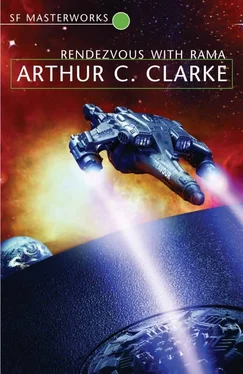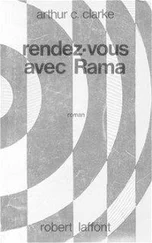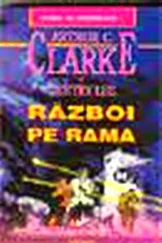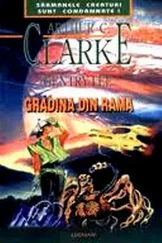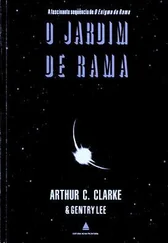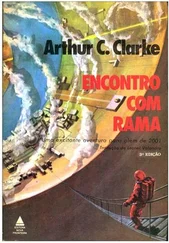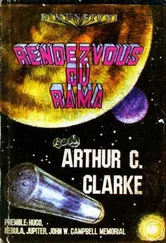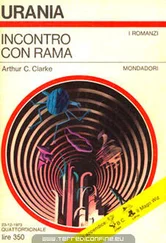Rama showed no such changes. Either it was not spinning at all or it was perfectly symmetrical. Both explanations seemed equally unlikely.
There the matter rested for several months, because none of the big orbiting telescopes could be spared from their regular job of peering into the remote depths of the universe. Space astronomy was an expensive hobby, and time on a large instrument could easily cost a thousand dollars a minute. Dr. William Stenton would never have been able to grab the Farside two-hundred-metre reflector for a full quarter of an hour, if a more important programme had not been temporarily derailed by the failure of a fifty cent capacitor. One astronomer’s bad luck was his good fortune.
Bill Stenton did not know what he had caught until the next day, when he was able to get computer time to process his results. Even when they were finally flashed on his display screen, it took him several minutes to understand what they meant.
The sunlight reflected from Rama was not, after all, absolutely constant in its intensity. There was a very small variation—hard to detect, but quite unmistakable, and extremely regular. Like all the other asteroids, Rama was indeed spinning. But whereas the normal “day” for an asteroid was several hours, Rama’s was only four minutes.
Dr. Stenton did some quick calculations, and found it hard to believe the results. At its equator, this tiny world must be spinning at more than a thousand kilometres an hour; it would be rather unhealthy to attempt a landing anywhere except at the poles. The centrifugal force at Rama’s equator must be powerful enough to flick any loose objects away from it at an acceleration of almost one gravity. Rama was a rolling stone that could never have gathered any cosmic moss; it was surprising that such a body had managed to hold itself together, and had not long ago shattered into a million fragments.
An object forty kilometres across, with a rotation period of only four minutes—where did that fit into the astronomical scheme of things? Dr. Stenton was a somewhat imaginative man, a little too prone to jump to conclusions. He now jumped to one which gave him a very uncomfortable few minutes indeed.
The only specimen of the celestial zoo that fitted this description was a collapsed star. Perhaps Rama was a dead sun—a madly spinning sphere of neutronium, every cubic centimetre weighing billions of tons… At this point, there flashed briefly through Dr. Stenton’s horrified mind the memory of that timeless classic, H. G. Wells’s The Star. He had first read it as a very small boy, and it had helped to spark his interest in astronomy. Across more than two centuries of time, it had lost none of its magic and terror. He would never forget the images of hurricanes and tidal waves, of cities sliding into the sea, as that other visitor from the stars smashed into Jupiter and then fell sunwards past the Earth. True, the star that old Wells described was not cold, but incandescent, and wrought much of its destruction by heat. That scarcely mattered; even if Rama was a cold body, reflecting only the light of the sun, it could kill by gravity as easily as by fire.
Any stellar mass intruding into the solar system would completely distort the orbits of the planets. The Earth had only to move a few million kilometres sunwards—or starwards—for the delicate balance of climate to be destroyed. The Antarctic icecap could melt and flood all low-lying land; or the oceans could freeze and the whole world be locked in an eternal winter. Just a nudge in either direction would be enough.
Then Dr. Stenton relaxed and breathed a sigh of relief. This was all nonsense; he should be ashamed of himself.
Rama could not possibly be made of condensed matter. No star-sized mass could penetrate so deeply into the solar system without producing disturbances which would have betrayed it long ago. The orbits of all the planets would have been affected; that, after all, was how Neptune, Pluto and Persephone had been discovered. No, it was utterly impossible for an object as massive as a dead sun to sneak up unobserved.
In a way, it was a pity. An encounter with a dark star would have been quite exciting.
While it lasted…
The extraordinary meeting of the Space Advisory Council was brief and stormy. Even in the twenty-second century, no way had yet been discovered of keeping elderly and conservative scientists from occupying crucial administrative positions. Indeed, it was doubted if the problem ever would be solved.
To make matters worse, the current Chairman of the SAC was Professor (Emeritus) Olaf Davidson, the distinguished astrophysicist. Professor Davidson was not very much interested in objects smaller than galaxies, and never bothered to conceal his prejudices. And though he had to admit that ninety per cent of his science was now based upon observations from space-borne instruments, he was not at all happy about it. No less than three times during his distinguished career, satellites specially launched to prove one of his pet theories had done precisely the opposite.
The question before the Council was straightforward enough. There was no doubt that Rama was an unusual object—but was it an important one? In a few months it would be gone for ever, so there was little time in which to act. Opportunities missed now would never recur.
At rather a horrifying cost, a space probe soon to be launched from Mars to beyond Neptune could be modified and sent on a high-speed trajectory to meet Rama. There was no hope of a rendezvous; it would be the fastest fly-by on record, for the two bodies would pass each other at two hundred thousand kilometres an hour. Rama would be observed intensively for only a few minutes—and in real close-up for less than a second. But with the right instrumentation, that would be long enough to settle many questions.
Although Professor Davidson took a very jaundiced view of the Neptune probe, it had already been approved and he saw no point in sending more good money after bad. He spoke eloquently on the follies of asteroid-chasing, and the urgent need for a new high-resolution interferometer on the Moon to prove the newly-revived Big Bang theory of creation, once and for all.
That was a grave tactical error, because the three most ardent supporters of the Modified Steady State Theory were also members of the Council. They secretly agreed with Professor Davidson that asteroid-chasing was a waste of money; nevertheless…
He lost by one vote.
Three months later the space probe, rechristened Sita, was launched from Phobos, the inner moon of Mars. The flight time was seven weeks, and the instrument was switched to full power only five minutes before interception. Simultaneously, a cluster of camera pods was released, to sail past Rama so that it could be photographed from all sides.
The first images, from ten thousand kilometres away, brought to a halt the activities of all mankind. On a billion television screens, there appeared a tiny, featureless cylinder, growing rapidly second by second. By the time it had doubled its size, no one could pretend any longer that Rama was a natural object.
Its body was a cylinder so geometrically perfect that it might have been turned on a lathe—one with centres fifty kilometres apart. The two ends were quite flat, apart from some small structures at the centre of one face, and were twenty kilometres across; from a distance, when there was no sense of scale, Rama looked almost comically like an ordinary domestic boiler.
Rama grew until it filled the screen. Its surface was a dull, drab grey, as colourless as the Moon, and completely devoid of markings except at one point. Halfway along the cylinder there was a kilometre-wide stain or smear, as if something had once hit and splattered, ages ago.
Читать дальше
